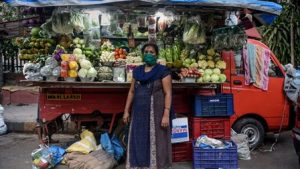Informal Work: Perspective on Definition, Measurement and Scope
Developmental policies need valid and relevant information regarding the informal sector's key indicators at national and regional levels.
In the post-COVID distressing times, there has been a renewed interest in the informal economy with growing debates over policy revisions, ensuring social security to the workers engaged in it.  Acknowledging that formal and informal sectors are interlinked through the capital, monetary and product intermediaries, it is agreed that the degree of regulation across the sector varies widely. Economists argue that the origin and expansion of the informal economic activities have their roots in inadequacy in organized sector employment creation. The unemployment rate in India in 2017–18 was at 45 year high at 6.1 per cent, while in March 2020, it rose to 8.8 per cent. The Periodic Labour Force Survey (PLFS) report of 2018–19 reveals that 68.4 per cent of the non-agricultural sector workers were engaged in the informal sector. With rising jobless growth, economic recessions, the unskilled labourers crowding the agriculture sector, eventually seek refuge in the informal sector.
Acknowledging that formal and informal sectors are interlinked through the capital, monetary and product intermediaries, it is agreed that the degree of regulation across the sector varies widely. Economists argue that the origin and expansion of the informal economic activities have their roots in inadequacy in organized sector employment creation. The unemployment rate in India in 2017–18 was at 45 year high at 6.1 per cent, while in March 2020, it rose to 8.8 per cent. The Periodic Labour Force Survey (PLFS) report of 2018–19 reveals that 68.4 per cent of the non-agricultural sector workers were engaged in the informal sector. With rising jobless growth, economic recessions, the unskilled labourers crowding the agriculture sector, eventually seek refuge in the informal sector.
Whatever be the names given to these kinds of activities, there lie some common aspects. They all fall outside the purview of government regulations, absence of account maintenance, use of simple technology and small scale of production. The growing importance of this sector can also be assessed from the fact that different forums have emerged, especially in developing nations like India, where dialogues, debates and resolutions are conceptualized for the upgrading of enterprises and workers involved and rightfully so. For instance, the establishment of the Women in Informal Employment Globalizing and Organizing (WIEGO) in 2007, the Unorganized Sector Workers Social Security Act 2008 and Unorganized Workers Condition of Work and Livelihood Promotion Bill drafted in 2005. Similarly, the Self-Employed Women’s Association (SEWA), a trade union, was established in 1972, which runs the massive contributory social protection scheme for India’s informal workers.
Migration as Survival Strategy
Economic distress among the agrarian population has pushed the poorer families to migrate to cities for informal work. Migration forms the backbone for a steady supply of cheap informal labour into the cities. They usually provide valuable services in heavy-demand labour-intensive sectors and personal-care jobs. Informality in work type and worker status makes the working population vulnerable to rampant exploitation in low and irregular payment, additional workload without compensation, no social security benefits and non-existent job security. The PLFS report of 2018–19 discloses that 70 per cent of the informal sector workers in India have no written job contract, 52 per cent are not eligible for any social security benefits.
The mass exodus of informal migrant workers from Delhi and Mumbai’s metropolises during the lockdown in the post-COVID-19 pandemic outbreak has been a real eye-opener on how unplanned reckless, reluctant and unsympathetic approach the government has towards them.
Also Read : Unorganised Sector and Social Security: Concerns Galore
Thus, at the foremost, it is wise to understand what constitutes informal work and how its domain can be accurately measured.
Definition and Measurement of Informal Activities
The term informal sector came to be widely used since introduced by Keith Hart in 1971. He categorically defined formal and informal sectors in terms of wage and self-employment. In 1972 International Labour Organisation (ILO) was first to propose the multi-criteria definition of this concept. Though both the definitions were loose, it paved the way towards recognizing the growing importance of those economic activities in providing livelihood opportunities.
Various names such as traditional, unorganised, unregulated, unstructured or transitional sectors are assigned interchangeably to indicate informal activities. Just like names, opinions differ widely about what constitutes informal work. According to SNA (1993) informal sector includes all ‘productive institutional units characterized by the low level of organization, little or no division between labour and capital, and labour relations based on casual employment and/or social relationships, as opposed to formal contracts’ (Delhi Group, 2006). The International Labour Conference 2002revised the informal economy’s definition as ‘all economic activities by workers and economic units that are in law or practice not covered or insufficiently covered by formal arrangements.’
Thereafter, the concept was redefined in terms of characteristics of the workers employed (employment approach) in the 17th International Conference on Labour Statisticians (ICLS) in 2003. It recognizes employment which are ‘not subject to national labour legislation, income taxation, social protection or entitlement to certain employment benefits dismissal, severance pay, paid annual or sick leave.’For better cross-country comparability, the United Nations (UN) Expert Group on Informal Sector Statistics (Delhi Group) was formed in 1997. Its task was to recommend a holistic and standard definition, including ’employment in the informal sector’ and ‘informal employment.’ The former emphasizes the production units while the latter on the jobs. Though agreed that the term ‘informal employment’ is misleading and may hamper proper policy resolution, it was retained because of its broadness. In contrast, the term ‘unprotected employment’ was dropped from the list.
But most of the definitions used are to identify urban informal sector, and relatively less emphasis is laid to measure the rural informal employment and enterprise in both agricultural and non-farm sectors. The 15th ICLS definition was criticized for being erroneous as it excluded large proportion of self-employed workers; freelancers outsource workers and sub-contractors, thereby adversely impacting enumeration of women who are more likely to be self-employed. Additionally, since people are usually simultaneously engaged in more than one employment category, often crisscrossing the boundaries of formal and informal territories; without a job-based enumeration approach, there would be a gross underestimation of the sector’s exact size and performance.
Indian Scenario
The NCEUS was established in 2004 to exclusively canvass the extent, needs and problems of the informal sector and its workers. Informal employment in India shelters around 92 per cent of the workforce, of which women constitute an overwhelming 95.9 per cent (NCEUS, 2007). Yet there was a lack of a comprehensive standardized definition for a long time;absence of which handicapped the description, identification, statistical estimation of employment and income generated and policy formulation for this sector.
 Factories Act 1948, distinguishes unorganised sector by threshold number of workers and electricity usage and non-registration of units. The Indian National Commission on Labour (1966-69) made the first effort in statistical tabulation and defining informal sector in India. National Sample Survey Organization (NSSO) 55th round conducted the first-ever nationwide survey on the informal sector enterprises in 1999-2000. But it was restricted only within the non-agricultural occupation. NSSO separates the informal economy in terms of broad sectoral divisions. Under the secondary sector, it identifies all those enterprises that are not covered under the Annual Survey of Industries (ASI) as unorganised,while for tertiary sector, all enterprises except those functionalised by central, state or local governments and those in the corporate sector are counted as unorganised.
Factories Act 1948, distinguishes unorganised sector by threshold number of workers and electricity usage and non-registration of units. The Indian National Commission on Labour (1966-69) made the first effort in statistical tabulation and defining informal sector in India. National Sample Survey Organization (NSSO) 55th round conducted the first-ever nationwide survey on the informal sector enterprises in 1999-2000. But it was restricted only within the non-agricultural occupation. NSSO separates the informal economy in terms of broad sectoral divisions. Under the secondary sector, it identifies all those enterprises that are not covered under the Annual Survey of Industries (ASI) as unorganised,while for tertiary sector, all enterprises except those functionalised by central, state or local governments and those in the corporate sector are counted as unorganised.
Two methods are used for measuring the size of informal sector, namely direct and indirect. The former requires a survey to be conducted to collect the data, but data sources already collected are used for calculation in the latter. This follows a residual method approach where the estimates from Census figures about the total population and Directorate General of Employment and Training (DGE and T) about the entire workforce employed in the organized sector are collected and the latter is deducted from the population figures to calculate the workers engaged in the informal sector.
The task of direct measuring is performed by NSSO and NCEUS. Before the 55th NSSO round indirect method, there was only a residual method in India. With the NSSO survey technique, Schedule 2 (enterprise questionnaire) and Schedule 10 (household questionnaire) came to be used.
Later, agricultural enterprise surveys were also conducted. Enumeration of those engaged in informal employment outside informal enterprises such as part-time workers, industrial outworkers, temporary and casual workers who don’t work for any permanent notified employer is also performed.
Also Read : National Employment Policy: Towards Creating an Atma Nirbhar Bharat
Casual farm and non-farm labourers (inclusive of day labourers), self-employed, employers, unpaid contributing family workers, contract labour, household workers, regular and casual wage earners constitute informal workers.
The unprecedented growth in employment in the informal economy calls for greater recognition and appreciation of these kinds of jobs and understanding the hardships faced by the workers regarding insufficient training, credit availability, social security benefits and market repercussions. This is true in the wake of frequent structural adjustments and by externalities such as the COVID-19 pandemic, which by far affect the informal sector in terms of overcrowding but lower productivity and heightened risks. Thus, not only governments but also non-governmental organizations (NGOs) should take significant steps in safeguarding the interests of the informal workers. This would ensure better participation of this group in India’s GDP and encompass better income earnings by facilitating skill enhancement, improving bargaining strength, cheap financial assistance, technical and infrastructural help. Developmental policies need valid and relevant information regarding the informal sector’s key indicators at national and regional levels. This specifies the utmost significance of a standardized definition and measurement technique at the elementary stage. Regular updating of statistics, measures, definitions and concepts matched with the changing economic structures would ensure an element of flexibility and dynamism needed for a holistic study and development of the heterogeneous and complex informal economy.
